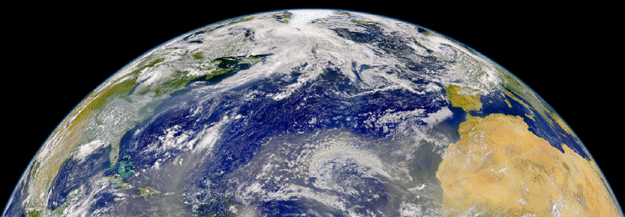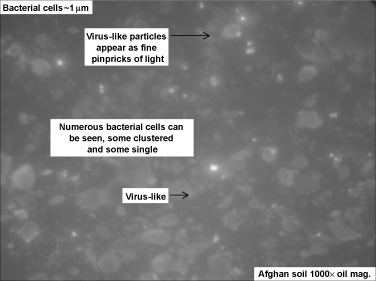Approximately 34% of Earth's terrestrial cover can be classified as deserts. The two desert areas that contribute the majority of desert dust to Earth's atmosphere are the Sahara and Sahel regions of North Africa and the Takla Makan and Gobi of Asia. The current estimates for the quantity of desert dust that moves some distance in our atmosphere each year ranges from 0.5 to 5 billion tons, with the Sahara and Sahel accounting for 50–75% of the total. Dust emanates from North Africa year-round and affects air quality regionally, in the Middle East, Europe, the Caribbean, and the Americas. Movement of dust from North Africa to the Caribbean and the Americas is seasonal, with movement to the northern Caribbean and Central and North Americas occurring during the Northern Hemisphere summer, and to the Southern Caribbean and South America during the Northern Hemisphere winter. Figure 1 illustrates a period of continuous transmission that has formed an atmospheric bridge extending from the west coast of Africa to the Caribbean and the Americas. Dust clouds moving across the Atlantic typically take 3–5 days to reach the Caribbean. In comparison, the Asian desert dust season occurs between February and April, but large events are capable of global dispersion in the Northern Hemisphere. A large Asian dust event in 1990 affected air quality in the North Pacific, North America, and the North Atlantic, and particles from this event were detected in samples collected in the French Alps. Dust clouds moving off the east coast of Asia take approximately 7 to 9 days to reach the Americas. In addition to these two prime source regions, though, dust storms are common in deserts around the globe, and dust events occurring in other deserts are capable of moving significant quantities of soil vast distances during optimal atmospheric conditions.

Influence of climate change and anthropogenic activity
Since the mid-1960s, a combination of climate flux and anthropogenic activity (development and agriculture) has resulted in a general increase in atmospheric dust transported from the deserts of North Africa and Asia. The North Atlantic Oscillation (NAO) is the position change over the North Atlantic Ocean of the Azores High and the Icelandic Low pressure systems. A more northerly position results in a decrease in precipitation over North Africa. The NAO has been predominantly in a northern position since the late 1960s, and the documented decrease in precipitation has coincided with an increase in dust transport from North Africa to the Caribbean and the Americas. Additionally, data recorded during years of El Niño (the climatic phenomenon associated with sea-surface temperature changes in the Pacific Ocean) demonstrate that this dust transport is further enhanced in those years. Given these conditions and anthropogenic activity along the Saharan perimeter, it is interesting that the overall size of this desert has not changed. However, one example of anthropogenic influence is the diversion of source waters from Lake Chad (bordered by Chad, Cameroon, Nigeria, and Niger) for agricultural and domestic use, which has resulted in drying of the lake [between 1963 and 1997, the water-surface area of the lake declined from 25,000 km2 to 1350 km2 (9650 mi2 to 520 mi2)]. Due to the fine nature of aquatic sediments, dried lake beds are a dominant source of dust in the atmosphere. Owens Lake in southern California was drained by the city of Los Angeles (for drinking water) by 1926 and is now the primary source of atmospheric dust in North America. The Aral Sea, located within Kazakhstan and Uzbekistan, has suffered a fate similar to that observed with Lake Chad and is another “dust hot spot.” A good example of the influence of anthropogenic activity on dust emissions is the loss of perimeter grasslands around the Asian deserts because of detrimental agricultural practices. Because of such practices, China lost ∼2100 km2 (810 mi2) to desertification each year between 1975 and 1987.
Although humans undoubtedly have contributed to the currently observed dust load rates, annual atmospheric dust loading rates have been much greater during glacial periods throughout Earth's history (more water stored as ice equals more exposed and drier soil). Likewise, during interglacial periods, the atmosphere has been much cleaner because the warming results in less ice cover and more precipitation (wet soils are heavier than dry soils and thus are not as susceptible to suspension in the atmosphere). During an interglacial period that occurred approximately 130,000 years ago, the Sahara was almost completely covered with vegetation.
Desert dust and microbiology
The amount of soil from uncovered ground that can be picked up between thumb and forefinger is about a gram in weight. Regardless of where one is on the planet, that 1 g of soil harbors approximately 1 million to 1 billion bacterial cells. While there are about 10,000 genotypes of bacteria in that community, most of the community is dominated by a few species, with species dominance being dependent on a combination of soil characteristics such as inorganic, organic, and water content. Also present are other microorganisms such as fungi (∼1 million per gram in some soils), viruses (∼100 million per gram in soils of high moisture content), and protozoa (∼10,000 per gram in wet soils). Surprisingly, desert soils harbor the upper range of ∼1 billion bacterial cells per gram of soil. Figure 2 illustrates the presence of bacteria and virus-like particles in a desert soil sample collected in Afghanistan. Although fungi, viruses, and protozoa are present in desert soils, they occur at lower concentrations than in most other soil types because of the lack of moisture. Because of the low water content of desert soils, many of the microorganisms present may be in a state of stasis (low metabolic activity, which is a survival strategy) and thus may not be as readily capable of rapid growth or cell division. The key to an increase in biotic activity in desert soils is the addition of water through precipitation. Film documentaries depicting the rapid and short-lived bursts of small-plant growth in deserts following precipitation events are an excellent reflection of what also occurs on the microbiological scale. From a microbial point of view, there is an alternative to growth induced by precipitation: the soils can be moved to more moist environments. This is precisely what large dust storms do: they move significant quantities of desert topsoil to environments that may favor more rapid microbial growth.

Dust storms: why should we care?
It is known that many terrestrial ecosystems benefit from dust transport (for example, plants in the Amazonian and Hawaiian rain forests derive nutrients from African and Asian dust, respectively). Why then should dust storms be of concern, given that dust has always moved through Earth's atmosphere? First, dust clouds moving over industrial, agricultural, and developed lands can pick up toxic compounds that are being emitted into the atmosphere and thus enhance the toxicity potential of a cloud. Emissions originating from the application of pesticides, herbicides, and other sources such as automotive exhaust are examples of the types of compounds that may adhere to dust-cloud particulates. Additionally, these same types of compounds may be present in dust-cloud source-region soils (that is, in the vicinity of dried lake sediments).
With regard to human health risk, toxic compounds may exacerbate the stresses associated with having to breathe particulate-laden air (penetration of particulate matter into the lung environment does not equate to good health) through effects such as immune suppression (active suppression of the immune response). Immune suppression in general is particularly important relative to pathogen exposure and may occur in plants as well as in animals. Dust-cloud research has shown that 20–30% of the culturable microorganisms are pathogenic (pathogens to some type of plant or animal), and in general the bacterial communities are diverse. One of the first pathogens identified in an African dust sample collected in the northern Caribbean was the sea fan pathogen, Aspergillus sydowii, a terrestrial fungus that cannot replicate in the marine environment but that has caused infections throughout the Caribbean Sea. It is possible that A. sydowii has been present in dust clouds since this species evolved, but recently, as a result of the introduction of anthropogenic toxins into these clouds, the fungus is now able to cause symptomatic infection. Enhanced dust-cloud toxicity that has an impact an ecosystem-wide health via direct toxicity or through synergy with pathogens is a prime concern.
Second, dust clouds may harbor crop or livestock pathogens through source-area contamination of soils or, similar to the concerns with toxins, may pick up these types of pathogens as the clouds move through agricultural areas. The end result is the potential for the delivery of pathogens to downwind agricultural regions where the same types of crops or livestock exist. Interestingly, in 2003, via experiments conducted aboard the marine-research vessel JOIDES Resolution during Ocean Drilling Program Leg 209, two fungal pathogens were isolated from African dust moving over the tropical mid-Atlantic (∼15°N, 45°W). One, Aspergillus dauci, is a pathogen of Florida carrots, and the other, Massaria platani, is the causative agent of Florida sycamore canker. Hence, the direct movement of crop, livestock, native plant or animal, or human pathogens to downwind environments, without regard to synergy, is certainly another concern.
Another big-picture synergistic effect arises from the fact that African dust has been identified as causing harmful algal blooms along Florida's southern and western coastal environments. The deposition of oceanic desert dust, because of its inorganic nutrient content such as iron (which can be utilized for growth in iron-depleted marine waters), has always contributed to the growth of microorganisms in marine waters. However, induced blooms of harmful algae in waters that are currently stressed by other factors, such as inadequate regional sewage-disposal practices, may push a compromised community (that is, the southeast Florida coral reef system) beyond a state of recovery. Of course, there are the more obvious impacts from dust-induced harmful algal blooms: direct loss of marine life, compromised human health via exposure to aerosolized algae toxins, and the resulting economic losses associated with tourism issues.
Obviously, desert dust storms that move around our planet warrant research focused on ecosystem and human health issues. It is clear from a survey of the literature that projects directed toward the identification of pathogen and toxin dissemination are sorely needed. Equally as interesting as the health issues are the questions associated with microbial ecology. What role do these dust clouds play in the distribution of beneficial and harmful microbial species? There are far too few research groups investigating desert dust microbiology. This field is wide open.
See also: Atmospheric general circulation; Climate modification; Desert; Desertification; Dust storm; Ecosystem; El niño; Microbial ecology; Microbiology; Precipitation (meteorology); Public health





